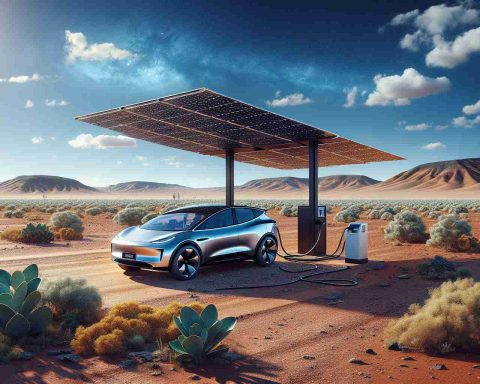The Evolution of Electric Vehicle Technology
Electric vehicles (EVs) are on the verge of a major breakthrough. Traditionally, an EV’s battery could either charge or discharge but not do both simultaneously. However, recent developments from General Motors could change this norm significantly.
A recent patent uncovered by the patent analysis platform CarMoses reveals GM’s innovative plan for a dual-purpose charging system. This system includes two separate charge ports: one for receiving power from an external source and another connected to a bi-directional charger. The genius of this design lies in its ability to enable the battery to charge while simultaneously supplying power to another source, enhancing the vehicle’s versatility.
One of the most exciting applications of this system is its potential to facilitate vehicle-to-vehicle charging. The patent illustrations show multiple EVs connected in a chain, allowing one car to transfer energy to another, potentially creating a network of energy sharing among electric vehicles.
While the concept of dual charge ports isn’t entirely new—seen in models such as the Porsche Taycan—it poses intriguing possibilities for energy management on the road. The practical applications of this technology remain to be explored, but the idea of interconnected EVs could redefine how we think about charging and power usage in the electric future. GM’s next steps will be closely watched as they pave the way for revolutionary changes in EV functionality.
The Broader Impact of Electric Vehicle Advancements
The recent innovations in electric vehicle (EV) technology, particularly with General Motors’ dual-purpose charging system, carry profound implications for society and the global economy. This breakthrough enables not just individual vehicle efficiency but fosters a paradigm shift in how we manage energy supplies. The concept of vehicle-to-vehicle (V2V) charging could potentially create a dynamic ecosystem of interconnected EVs, wherein vehicles can act as mobile power stations. In densely populated urban areas, this could relieve pressure on fixed charging infrastructure, fundamentally altering urban planning and energy deployment strategies.
Moreover, the long-term significance of this technology extends to environmental considerations. As the world grapples with climate change and the need for sustainable energy solutions, V2V technology could promote renewable energy utilization. By facilitating energy sharing among EVs, areas reliant on intermittent power sources, such as solar and wind, can mitigate energy scarcity during peak usage times. This flexibility could reduce dependence on fossil fuel-based power generation, further driving down overall carbon emissions.
In terms of future trends, the rise of bi-directional charging technologies could herald a new era of energy management, where EV owners not only consume but also distribute energy. As EV adoption continues to rise—projected to reach over 300 million globally by 2040—this technology will play a pivotal role in shaping how energy is consumed and shared in a more sustainable future. The intersection of innovative vehicle technology and energy management embodies a significant step towards an eco-friendlier society and a resilient economy.
The Future of Electric Mobility: How GM is Revolutionizing EV Charging
## The Evolution of Electric Vehicle Technology
Electric vehicles (EVs) are rapidly evolving, with advancements paving the way for more efficient and versatile applications. One of the most groundbreaking innovations comes from General Motors (GM), which has recently been granted a patent for a dual-purpose charging system that could significantly shift paradigms in electric mobility.
What is the Dual-Purpose Charging System?
GM’s innovative dual-purpose charging system features two separate charge ports. The first port is designed for traditional charging from an external energy source, while the second is attached to a bi-directional charger. This unique setup allows the vehicle’s battery to charge while simultaneously supplying power to an external device, such as another EV or a home appliance.
Key Applications and Benefits
1. Vehicle-to-Vehicle Charging (V2V): Perhaps the most transformative application of this technology is the potential for vehicle-to-vehicle charging. This capability could allow one EV to recharge another, making it possible for drivers to assist each other in times of need, thereby reducing range anxiety and increasing travel flexibility.
2. Energy Sharing Networks: GM’s plan suggests the possibility of creating a network where multiple electric vehicles can be interconnected, functioning as a collective power source. This could lead to innovative arrangements for energy management, especially in emergencies or during peak electricity demand periods.
3. Enhanced Versatility: The ability to both charge and discharge energy simultaneously means that EVs can serve multiple purposes beyond transportation. This opens up new possibilities, such as using the vehicle as a backup power source during outages.
Limitations and Considerations
While the dual-purpose charging system holds much promise, there are key considerations:
– Infrastructure Requirements: Widespread adoption of V2V and energy-sharing capabilities will require significant infrastructural changes, including compatible charging stations and regulatory frameworks.
– Battery Lifecycle and Degradation: Frequent charging and discharging could affect battery health and longevity. Manufacturers will need to ensure that their battery systems are equipped to handle these demands without premature degradation.
Market Trends and Innovations
The adoption of such technologies aligns with market trends toward more integrated and sustainable transportation solutions. As electric vehicle sales continue to increase, innovations such as GM’s dual-purpose charging system could make EVs more attractive to consumers by enhancing their functionality and efficiency.
Insights and Predictions
As electric vehicle technology continues to advance, we can expect:
– Increased Competition: Other manufacturers are likely to follow GM’s lead, fostering a competitive environment that spurs further innovation and lowers prices.
– Broader Adoption of EVs: Enhanced capability through technologies like V2V charging may make electric vehicles more appealing to a broader range of consumers, especially those concerned about charging networks and policies.
– Sustainability Initiatives: Companies will need to focus on sustainability within their production and operational practices to meet growing consumer expectations regarding environmental impact.
Conclusion
The advancements in electric vehicle technology, particularly through GM’s dual-purpose charging system, represent a significant leap forward in how we perceive energy management in mobility. The implications of V2V charging could redefine not only the convenience of owning an electric vehicle but also enhance our overall approach to connecting energy usage with transportation. As the industry watches GM’s next steps, the evolution of electric vehicles promises to reshape our driving experience for the better.
For further insights on electric vehicle technologies and trends, visit Electric Vehicles.









